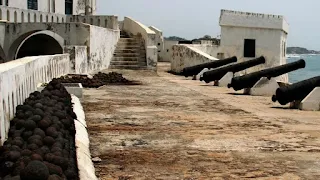My Visit to Ghana’s Slave Castles: A Review From Someone Who Walked Through the History

|
| Cape Coast Slave Castle in Ghana |
My Visit to Ghana’s Slave Castles: A Review From Someone Who Walked Through the History
I recently traveled to Ghana and visited the three largest slave castles on the country’s coast—Cape Coast Castle, Elmina Castle, and Fort St. Jago. Before this trip, I had read about the transatlantic slave trade. I had seen photos. I had studied timelines. But nothing prepared me for standing inside those stone walls, touching their damp floors, or stepping into the dungeons where millions of Africans were imprisoned.
What I witnessed is difficult to put into words. These castles are not just historical sites; they are places where grief and memory still cling to the air. My review reflects what I saw, what the guides explained, and what I felt as a visitor seeking to understand a world-shaping tragedy at its source.
The Weight of the History
Between 1482 and 1786, European powers built more than 40 coastal forts and slave castles along what was then called the Gold Coast. These sites held gold, ivory, spices—and later, millions of enslaved African men, women, and children. They were marched from inland regions, sorted, branded, imprisoned, and shipped across the Atlantic to slavery in the Americas.
The castles were engineered for profit, not humanity. The guides made that clear from the moment we entered.

Cape Coast Castle
Built by the Portuguese in the 15th century and expanded by the British, Cape Coast Castle is the largest and most recognized of Ghana’s slave castles. My guide led us down a narrow stairwell into the dungeons. The air was cold and stale. The walls were scarred with centuries of human suffering. Up to 1,000 enslaved people were once crammed into these chambers at a time with almost no ventilation and only one tiny window.
Above these dungeons, European officials lived in airy rooms overlooking the sea. The contrast felt unbearable.
Elmina Castle
Elmina Castle, built in 1482 by the Portuguese, is the oldest European building in West Africa. Standing in its courtyard, I could almost hear the echoes of the countless lives forced through its gates.
Elmina once processed as many as 30,000 enslaved Africans per year. The tour takes you through the women’s dungeon, the governor’s balcony, and the infamous “Door of No Return,” where Africans were forced onto ships bound for the Americas.
Fort St. Jago
Fort St. Jago sits on a hill opposite Elmina Castle. It was originally a military stronghold and lookout. From the top, the view is beautiful—almost painfully so. But the guide reminded us this vantage point was used to monitor ships, resist rival European powers, and tighten control over the slave trade.
What the Guides Want Every Visitor to Remember
My guide said something I will never forget:
“This place was built to break people. It is now here to teach people.”
The castles are UNESCO World Heritage Sites today, but they remain active memorials. The guides share vivid, verified historical accounts—how enslaved people were punished, how they resisted, and how they were traded for guns, textiles, beads, alcohol, and manufactured goods. They also speak honestly about the role some African kingdoms—including the powerful Ashanti Empire—played in capturing and selling other Africans.
This nuance matters. It presents a fuller, harder truth about global slavery: it was a system of European exploitation, built on both external demand and internal political dynamics.
Walking Through the Door of No Return
The most emotional moment of the tour came when we reached the Door of No Return at Cape Coast Castle. I stood in the doorway, staring out at the Atlantic. Waves crashed against the rocks. The tide rolled in. It hit me that millions of people had seen this same view but were never allowed to return home.
No book, documentary, or museum exhibit can replicate that feeling.
Fort Metal Cross and the Wider Network
The guide explained that Ghana once held around 40 slave forts and castles, built and occupied by Portuguese, Dutch, British, German, Danish, Swedish, and Spanish traders. Fort Metal Cross in Dixcove, built by the Dutch in the 17th century, also played a role: part military post, part commercial warehouse, and part holding facility for enslaved Africans.
Why These Sites Matter Today
Ghana’s castles do not exist simply to remind visitors of tragedy. They also teach about resistance, survival, and human dignity. They force us to confront how the slave trade shaped the world—and how its consequences still ripple through Africa, the Americas, and Europe.
I ended my tour with the same quote that appears at the museum:
"Slavery is not something from the past. It still has tragic consequences today." — Gabriela Ramos, UNESCO
Visiting these castles is emotional, difficult, and necessary. It is history you feel in your body as much as you learn with your mind. If you travel to Ghana, I urge you to go—not as a tourist, but as a witness.


























